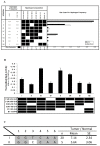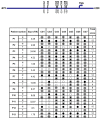Investigating the Promoter of FAT10 Gene in HCC Patients
- PMID: 29949944
- PMCID: PMC6070910
- DOI: 10.3390/genes9070319
Investigating the Promoter of FAT10 Gene in HCC Patients
Abstract
FAT10, which is also known as diubiquitin, has been implicated to play important roles in immune regulation and tumorigenesis. Its expression is up-regulated in the tumors of Hepatocellular Carcinoma (HCC) and other cancer patients. High levels of FAT10 in cells have been shown to result in increased mitotic non-disjunction and chromosome instability, leading to tumorigenesis. To evaluate whether the aberrant up-regulation of the FAT10 gene in the tumors of HCC patients is due to mutations or the aberrant methylation of CG dinucleotides at the FAT10 promoter, sequencing and methylation-specific sequencing of the promoter of FAT10 was performed. No mutations were found that could explain the differential expression of FAT10 between the tumor and non-tumorous tissues of HCC patients. However, six single nucleotide polymorphisms (SNPs), including one that has not been previously reported, were identified at the promoter of the FAT10 gene. Different haplotypes of these SNPs were found to significantly mediate different FAT10 promoter activities. Consistent with the experimental observation, differential FAT10 expression in the tumors of HCC patients carrying haplotype 1 was generally higher than those carrying haplotype II. Notably, the methylation status of this promoter was found to correlate with FAT10 expression levels. Hence, the aberrant overexpression of the FAT10 gene in the tumors of HCC patients is likely due to aberrant methylation, rather than mutations at the FAT10 promoter.
Keywords: FAT10; SNPs; expression; methylation; promoter.
Conflict of interest statement
The authors declare no conflict of interest. The founding sponsors had no role in the design of the study; in the collection, analyses, or interpretation of data; in the writing of the manuscript, and in the decision to publish the results.
Figures






Similar articles
-
The Role of FAT10 in Alcoholic Hepatitis Pathogenesis.Biomedicines. 2020 Jul 1;8(7):189. doi: 10.3390/biomedicines8070189. Biomedicines. 2020. PMID: 32630199 Free PMC article. Review.
-
Expression of the FAT10 gene is highly upregulated in hepatocellular carcinoma and other gastrointestinal and gynecological cancers.Oncogene. 2003 May 1;22(17):2592-603. doi: 10.1038/sj.onc.1206337. Oncogene. 2003. PMID: 12730673
-
p53 negatively regulates the expression of FAT10, a gene upregulated in various cancers.Oncogene. 2006 Apr 13;25(16):2318-27. doi: 10.1038/sj.onc.1209220. Oncogene. 2006. PMID: 16501612
-
As an independent prognostic factor, FAT10 promotes hepatitis B virus-related hepatocellular carcinoma progression via Akt/GSK3β pathway.Oncogene. 2014 Feb 13;33(7):909-20. doi: 10.1038/onc.2013.236. Epub 2013 Jul 1. Oncogene. 2014. PMID: 23812429
-
Integrative analysis of aberrant Wnt signaling in hepatitis B virus-related hepatocellular carcinoma.World J Gastroenterol. 2015 May 28;21(20):6317-28. doi: 10.3748/wjg.v21.i20.6317. World J Gastroenterol. 2015. PMID: 26034368 Free PMC article. Review.
Cited by
-
FAT10 is a Prognostic Biomarker and Correlated With Immune Infiltrates in Skin Cutaneous Melanoma.Front Mol Biosci. 2022 Mar 1;9:805887. doi: 10.3389/fmolb.2022.805887. eCollection 2022. Front Mol Biosci. 2022. PMID: 35300113 Free PMC article.
-
The case for FAT10 as a novel target in fatty liver diseases.Front Pharmacol. 2022 Nov 1;13:972320. doi: 10.3389/fphar.2022.972320. eCollection 2022. Front Pharmacol. 2022. PMID: 36386217 Free PMC article. Review.
-
Upregulated Ubiquitin D is a Favorable Prognostic Indicator for Rectal Cancer Patients Undergoing Preoperative Concurrent Chemoradiotherapy.Onco Targets Ther. 2022 Oct 11;15:1171-1181. doi: 10.2147/OTT.S378666. eCollection 2022. Onco Targets Ther. 2022. PMID: 36238133 Free PMC article.
-
Alcoholic-Hepatitis, Links to Brain and Microbiome: Mechanisms, Clinical and Experimental Research.Biomedicines. 2020 Mar 18;8(3):63. doi: 10.3390/biomedicines8030063. Biomedicines. 2020. PMID: 32197424 Free PMC article. Review.
-
The Role of FAT10 in Alcoholic Hepatitis Pathogenesis.Biomedicines. 2020 Jul 1;8(7):189. doi: 10.3390/biomedicines8070189. Biomedicines. 2020. PMID: 32630199 Free PMC article. Review.
References
LinkOut - more resources
Full Text Sources
Other Literature Sources

